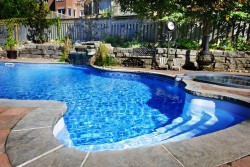By: William “Bill” Hurst, Attorney
It’s “hot” outside and the swimming suits are coming out for swimming and other water related activities. Americans swim daily in pools, oceans, lakes, rivers, and spas each year. Most people have a safe and healthy time, however it’s important to be aware of ways to prevent drowning and other health risks related to pool accidents.
According to the Center for Disease Control (“CDC”), every day approximately 10 people die from drowning, and of the 10 people, 2 are children under the age of 14. Drowning ranks 5th among the leading cause of accidental injury death in the United States. In the young age group nearly 1 in 3 accidental deaths are from drowning. For every drowning death in those aged 14 and under there are 4 visits to the ER for near drowning which can result in lifelong injury including brain damage. Of those injured 4 of 5 drowning victims are boys or men according to the CDC drowning statistics. In older teens (age 15 and up) and adults, most drownings occur in natural settings like lakes, rivers and oceans. Alcohol is a factor in nearly half of the drowning in this age group according to the CDC.
The CDC reports that most young children who drown in pools were last seen in the home and has just been out of sight less than 5 minutes, and were in the care of one or both parents at the time. As a result of all these education programs drowning rates have been declining, but drowning still remains the second leading cause of injury related to death for children. According to the USPSC, a child can drown in less time than it takes to answer the phone. That’s why it’s critically important you never leave the children unattended when they’re swimming in a pool. And that’s why any child younger than 5 years old should always be within arm’s reach.
There are 10,000,000 residential swimming pools across the United States and another 310,000 public swimming pools according to the CDC. It is noted that swim classes for children drastically reduce drowning risks. But no matter what you’re doing, riding or a jet ski or hopping on a canoe, one must remember that lifejackets save lives. In boating accidents 90% of the people who drowned were not wearing lifejackets according to the CDC and in 2009 there were 736 deaths and more than 3,300 injuries from boating accidents.
To improve pool and spa safety the U.S. Consumer Product Safety Commission (“CPSC”) has launched a national public education campaign to reduce childhood drowning, non-fatal submersion injuries and entrapment. www.poolsafety.gov. Through education and public awareness the pool safety campaign is alerting the general public and industry professionals about water safety steps to improve safety at pools and spas nationwide. This education also teaches about drain entrapments and how to prevent them. A drain entrapment occurs when a body is held against a pool or spa drain by the force of the pool’s suction, or when an article of clothing, etc. is caught in a faulty drain. Children’s public wading pools and others that are designated for children or inground spas that have a flat drain and/or a single main drain system pose the greatest risk of entrapment. We must recognize this hazard in advance to avoid the risk. During the 1970s the CPSC staff began investigating reports of incidents in pools and spa suction and entrapment. The most recent report shows that between 1999 and 2009 there were 94 reported entrapments. Of the 94 there were 12 fatalities and 79 injuries. There are several drain covers or anti-trapping devices that can be purchased which are well known to qualified pool maintenance companies.
The American Red Cross has also been very active in assimilating information to prepare your home and family for pool safety. They list a number of priorities and guidelines to follow to ensure safety, particularly for the children. Most cities and counties have specific ordinances making requirements which may be in addition to the recommendations the Red Cross which recommends you secure the pool with a barrier of at least a 4 foot high fence with a self-closing, self-latching gate along with safety covers or the pool when not in use and the removal of ladders or steps used for access. Most importantly, of course, is keeping children under active supervision whenever they’re around a pool and never allowing anyone to swim alone. They recommend that every pool owner establish and enforce rules of safe behaviors such as no diving, stay away from drain covers, swim with a buddy, and the like. A number of their recommendations may be found at www.redcross.org/prepare/water_safety/home_ pool_safety.
Regarding children the Red Cross stresses the necessity of having adult supervision in and around swimming pools and spas. They urge that anytime that you are distracted for a telephone call or restroom call children should be taken out of the pool. You should always maintain a clear view of your children and use lifejackets rather than inflatable flotation devices for children who cannot swim. When the pool is not in use multiple layers of barriers isolating the pool or spa from children should be installed in addition to an isolation fence. A number of other safety devices should be included, including a swimming pool/spa alarm which would indicate when somebody is in the pool. There are a number of pool gadgets currently on the market to help make your pool safer, in particular in an attempt to childproof it although nothing is foolproof when it comes to protecting children from drowning. There are self-locking gates and rigid covers that slide over the pool like garage doors, there are alarms, some are even worn on the child’s wrist like a watch and sounds upon contact with the water.
As an interesting point, poison control centers receive as many as 10,000 reports of exposure to chlorine and pool chemicals annually, with 2 in every 5 cases involving children under the age of 6 according to the CDC. Another 4,000 cases are reported for respiratory and eye irritation, usually from improper storing, mixing and using of pool chemicals. You must stir pool chemicals separately in a dry place away from heat and direct sunlight. You cannot mix chemicals, particularly with chlorine based products.
Dirty pool water is often a hazard for summer as it is a breeding ground for harmful bacteria and germs that can cause sickness and infections. You must make an effort to keep your swimming pool as clean as possible to minimize this possibility. You need to regularly sanitize the pool with chlorine and test the water, remove debris every day and shock your pool with a liquid pool shock at least once a week, and perhaps even more often if you use the pool frequently.
The CPSC finds that 69% of the accidents occurred while one or both parents were responsible for supervision, 10% were adults other than parents, 14% were sitters, and 7% were siblings. Most of these pool drownings are in a pool owned by the child’s family and the greatest percentage of the children who drown were last seen in the house before being found in the pool. “Maintaining safety for swimmers and non-swimmers requires constant vigilance and there is just too much going on at a party for any person to provide that.
If you or your child has been injured in a swimming accident, contact our office for a free evaluation of the potential claim(s) or call toll free at 1(800)636-0808 to speak with an experienced personal injury attorney. You can see us for free and were only paid if we recover.¡Hablamos Español!
Related Blogs:






